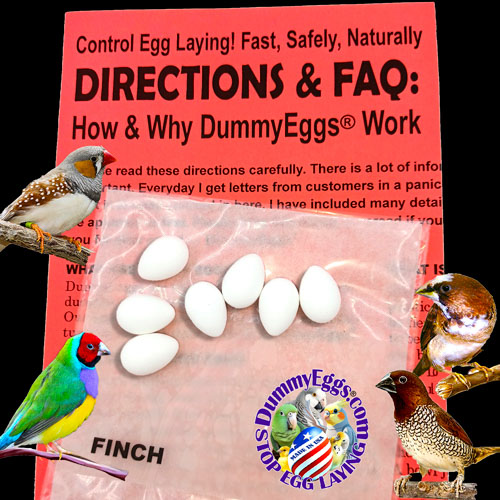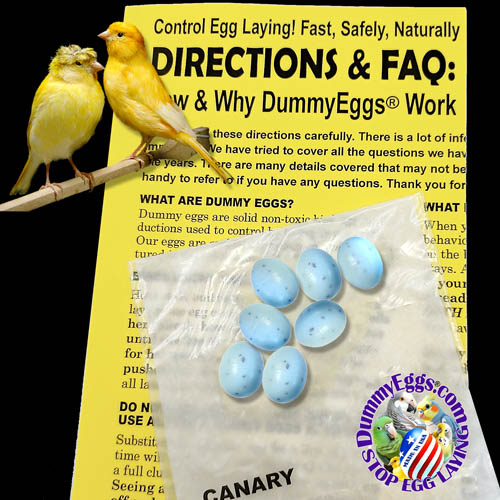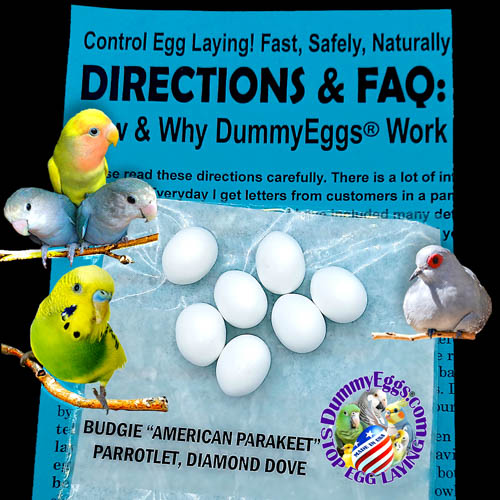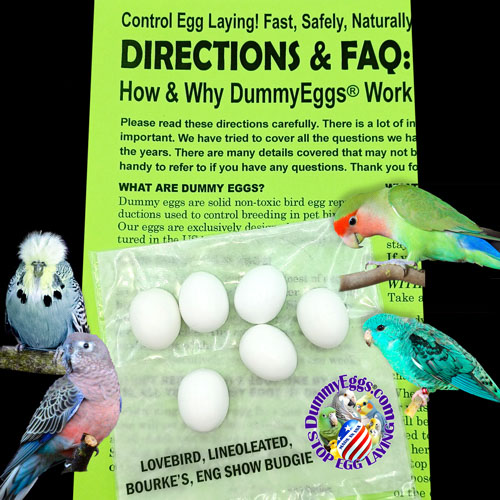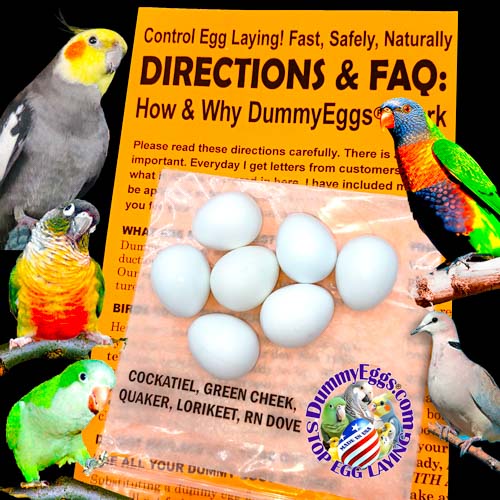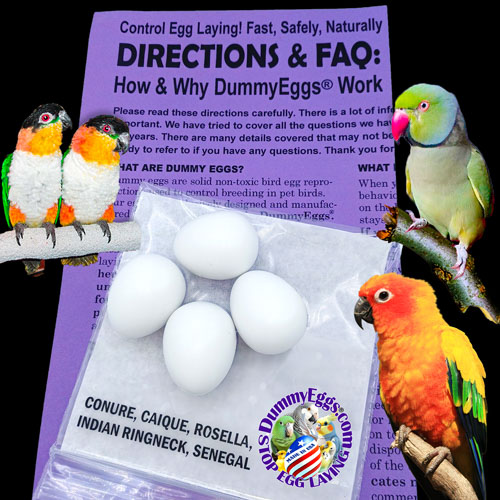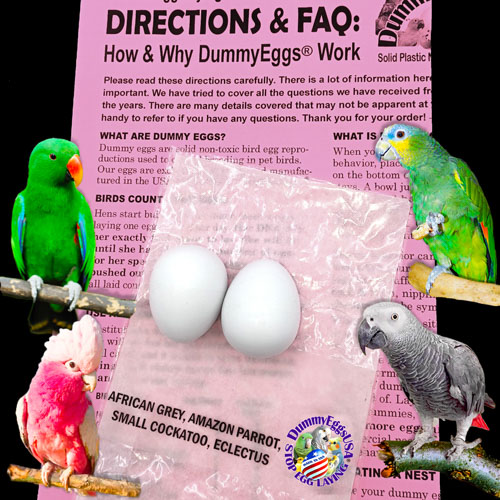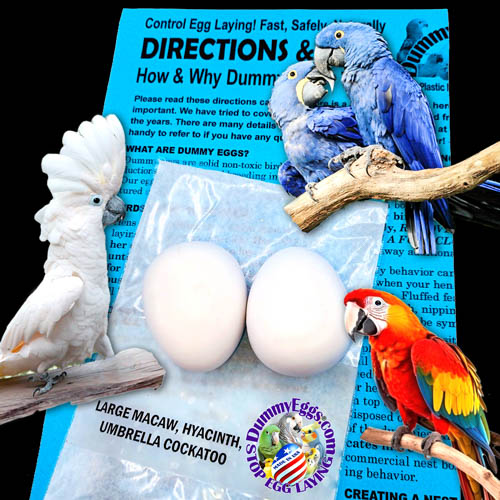7 Essential Tips to Use Plastic Bird Dummy Eggs
WHAT ARE DUMMY EGGS?
Dummy eggs are solid non-toxic bird egg reproductions used to control breeding in pet birds. Our eggs are exclusively designed and manufactured in the USA since 2006 by DummyEggs®.
BIRDS COUNT THEIR EGGS!
Hens start laying one egg every other day. Her hormones tell her how many to lay for her species. Extra eggs will be pushed out to leave the correct number in her clutch or nest. DummyEggs uses this amazing natural behavior to control egg laying in birds.
DO NOT REPLACE LIVE EGGS ONE BY ONE!
USE ALL YOUR DUMMY EGGS AT ONCE!
Substituting one dummy egg as she lays, will NOT signal that it is time to stop laying. Only seeing a full clutch turns off her egg laying hormones and turns on her incubating behavior.
DummyEggs cannot stop mother nature...
just try to guide her a little.
At DummyEggs® our point of view is to give her a nest simulation so she can behave normally. There are no health concerns with a healthy hen who is laying normal natural eggs for reproduction. Dummy eggs cannot stop your bird from ever laying another egg which would not be healthy. Don’t deprive your bird of basic comforts that are often advised, as added stress is not what she needs. Give her the eggs to sit on as nature intended.
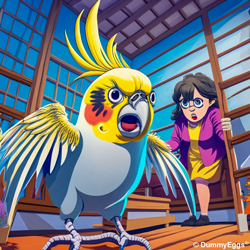
WHAT IS BROODY BEHAVIOR?
Broody or brooding behavior can start before any eggs are laid. Personality changes include fluffed feathers, backing up and rubbing on whatever is convenient, rocking back and forth, nipping and hissing. Your once affectionate friend may recoil from being touched at this time. Natural hormonal breeding instincts kick in and can be present in both partners. This is temporary although it may last the 2 - 4 weeks of her breeding cycle. Don’t show stress, be patient and give her DummyEggs!
PLACING & REMOVING EGGS IN A BOWL
If possible place and remove any eggs, real or plastic, when she can’t see you. If she acts a little frantic, be patient! Try fresh millet to distract her. Place ALL your dummy eggs in a shallow flat bowl large enough for her to sit in comfortably. Remove all her live eggs if any. Then put this nest bowl at bottom of cage or where ever your bird is comfortable. Fill with shredded white paper towels or “Natural Paper Bedding” with no odor absorption. Newspaper inks stain the plastic. Don’t use a commercial nest box either, as these encourage nesting behavior.
Ideally your bird will lose interest within 2-4 weeks and you will remove the dummy eggs the same way. Leaving them in longer may render them ineffective for her next clutch. Remove them after the number of days listed in our incubation chart above. If she is still shaken after 2 hours, replace the nest bowl and try again tomorrow, perhaps at a different time of day. Clean the plastic egggs, bowl and paper often.
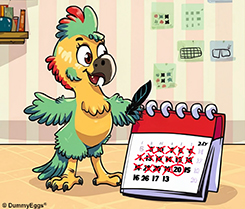
HOW LONG BEFORE SHE LAYS AGAIN?
The time between reproductive cycles varies by species. Brooding behavior will signal when it is time to reuse your dummy eggs. Put your fake eggs back in her nest before she starts laying, when you see brooding behavior, as soon as she lays her first egg or replaces an entire clutch.
Egg laying can depend on many internal and external factors. Sometimes juveniles start before they are ready to be good parents. Many large parrots such as large Macaws, Cockatoos and Hyacinths do not lay their first eggs until they are mature and in their 20’s.
ARE THEY SAFE?
HOW DO I CLEAN THEM?
Dummy eggs are safe, non-toxic, unbreakable, and reusable. Our dummy eggs are solid polyurethane, an inert plastic that does not break down or dissolve. Eggs can be cleaned with detergent and bleach or placed in the dishwasher.
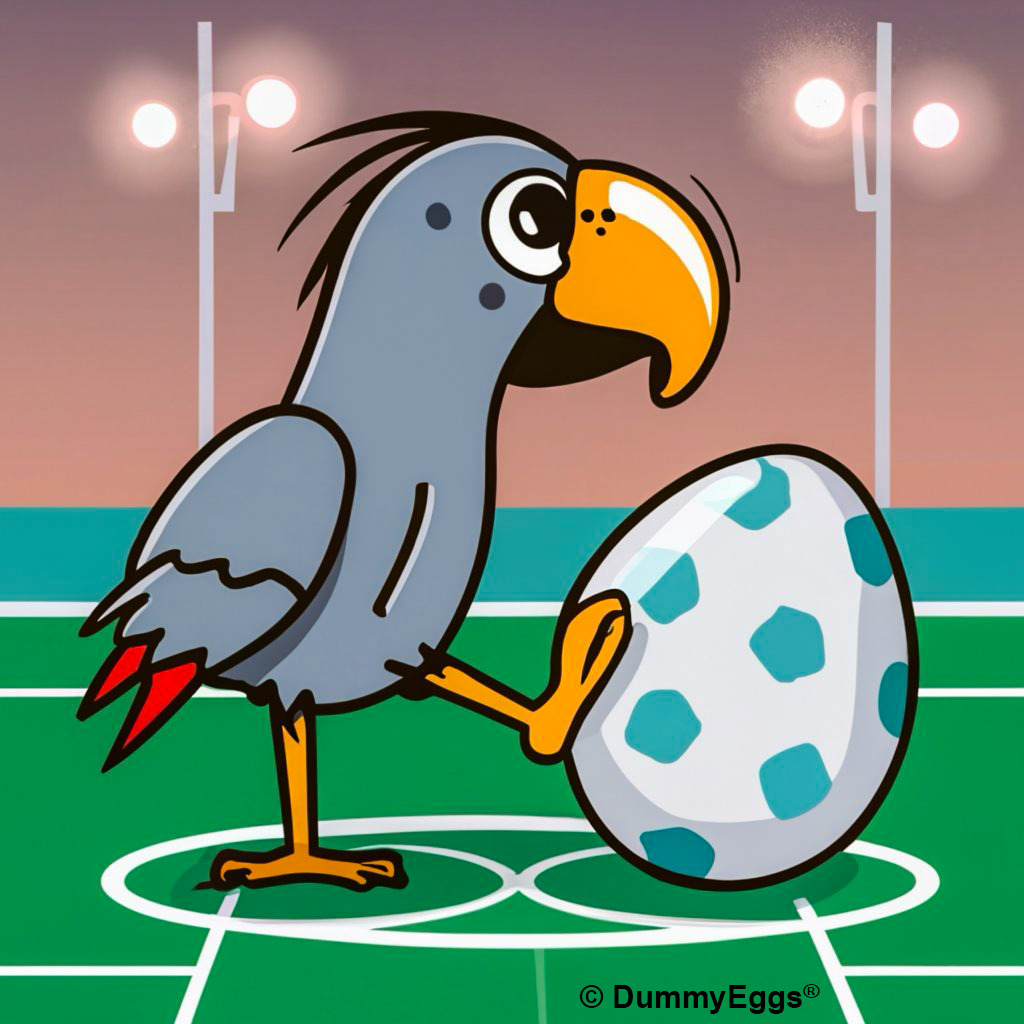
REASONS FOR REJECTION
Most birds will not reject a plastic egg with a slight difference in size, color, shape, or texture. If it looks close to their egg, they will accept it. Birds may reject DummyEggs due to a foreign scent, or they can be laid from a perch smashing to the floor. Birds break eggs by pecking or kicking them. And many, especially juveniles, don’t have maternal instincts yet, with no interest in incubating them. These same birds can easily become chronic egg layers and DummyEggs can help avoid this.
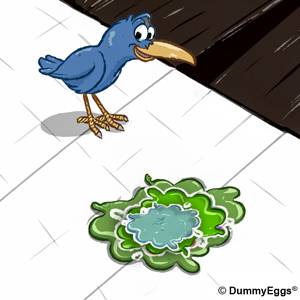
ARE GIANT DROPPINGS NORMAL?
After sitting on her eggs for many hours, the female will leave her nest to eat, drink and eliminate. A bonded male and female may take turns sitting on the eggs. Don’t be alarmed if your hen’s droppings are much larger than their normal size. This is a sure way to tell when brooding starts and stops.
DISRUPTING HER ROUTINE
If you your bird is truly a chronic egg layer, you could take additional measures to disrupt her routine. Move her cage, rearrange the things in it, set up new and shorter hours for being uncovered, change her diet to less treats and more pellets. Birds lay when they feel secure and at home. Let us make her feel like she is on vacation, but not lost in the woods.
WHAT IF THEY ARE FERTILE / INFERTILE?
Birds will lay eggs with or without a mate. She will lay eggs during each breeding cycle and will incubate them regardless of whether they have been fertilized.
AVIAN HEALTH CONDITIONS:
CALCIUM BLOCKS & CUTTLEBONES ARE A MUST! The freshest cuttlebone can be purchased in 5 lb. bulk boxes from Amazon.com and other retailers.
CHRONIC EGG LAYING: It isn’t normal egg laying when it goes on continually for weeks or months. Chronic egg laying can result from removing eggs as birds will replace them. A full clutch of can stop laying and trigger incubation.
Chronic egg laying depletes calcium levels and can cause soft shell eggs. Soft shell eggs are hard to pass, resulting in Egg Binding. An egg-bound bird needs immeditate medical attention.
HORMONAL SUPPRESSANTS: Your avian vet can give hens hormone shots which can be expensive and last only a few months, much like birth control pills. Use dummy egg therapy in conjunction with your veterinarian.
ENHANCING CHICK SURVIVAL
Using large parrot dummy eggs is a crucial strategy for breeders focused on increasing chick survival in large parrot species. By temporarily replacing real eggs with dummy eggs, breeders and owners can carefully control the timing of incubation, ensuring all chicks hatch together. This synchronized hatching reduces sibling competition and gives each chick an equal chance to thrive. Dummy eggs also help prevent accidental damage to fragile eggs, allowing for safer handling and monitoring. For breeders committed to raising healthy, robust parrots, dummy eggs are an indispensable tool in optimizing chick survival and ensuring the success of each clutch.
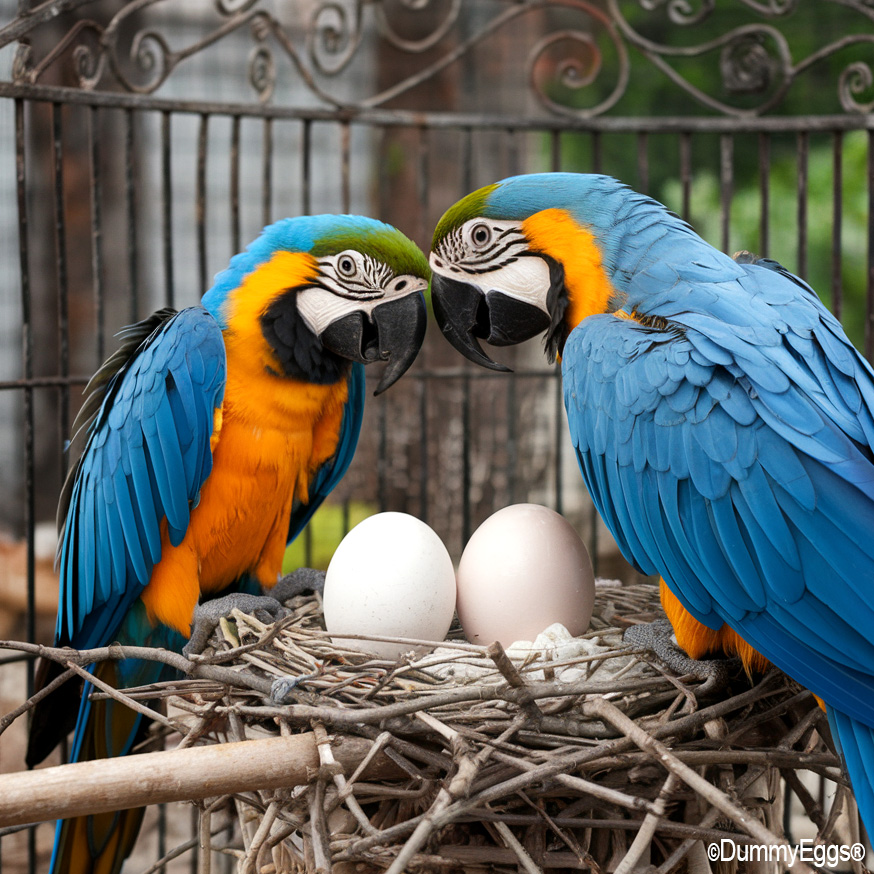
In addition to enhancing chick survival, large parrot dummy eggs play a vital role in preventing calcium depletion in breeding females. When a real egg is lost, a parrot may lay another to replace it, which can strain her calcium reserves and impact her health. By substituting the lost egg with a dummy egg, breeders can prevent this unnecessary egg-laying cycle, helping to maintain the bird’s calcium levels and overall well-being. This proactive approach supports healthier breeding females and contributes to the long-term success of your breeding program.
“Help Us Prevent & Protect Homeless Birds”
©DummyEggs.com®
WHAT YOU NEED TO KNOW
Incubation & Clutch Size Chart
This chart gives you the minimum number of eggs you need to buy for your bird. Plus, it tells you the number of days her species needs for incubation, which determines how long you leave your dummyeggs in her nest per breeding cycle.
SPECIES
DUMMY EGG SIZE
Length x Width
AVG. CLUTCH
How many eggs in nest
AVG. INCUBATION
How long to leave in nest
5
4
6
23
21
18
4
24
24
24
25
4
3
2
2
2
29
28
30
25
14
® DummyEggs.com
Introduction to DummyEggs®.com
If you’re a bird owner dealing with unwanted egg laying you have three options:
- Do nothing and allow the bird to lay her clutch and let nature take its course. If they hatch, this can mean you will have round-the-clock feedings and have to find homes for the surviving chicks. If the eggs are infertile, you can let the bird continue incubating them, but after some weeks, the real eggs spoil and probably break.
- Remove the eggs, and your bird will continue to lay replacement eggs until she has a full clutch. If eggs are constantly removed this can never be achieved. This can lead to calcium depletion and egg binding, an urgent medical condition which requires immediate care by a veterinarian.
- Replace your bird’s real eggs with DummyEggs®. These eggs mimic the look, feel, and weight of real eggs and will trigger incubation WITHOUT HER LAYING a full clutch of her own eggs. By using the correct number of DummyEggs®, you can limit the number of eggs your bird lays and prevent potential health complications.
DummyEggs® can also be used in the same manner when your bird first starts to display hormonal brooding behaviors that you will be sure to notice. These can include not wanting to be touched, wanting to be touched too much, and unusual aggression. Both males and females will show these signs, and using our plastic eggs can both calm and satisfy their need to reproduce.
So, which option is best for you and your bird? The choice is yours. We highly recommend the use of DummyEggs® to limit the number of eggs your bird lays, minimize stress for you and your bird, and prevent potential health complications. The proper way to use DummyEggs® is to put in the same number of eggs as she would lay in a full clutch. This "fake clutch" tricks her to stop laying and start sitting her nest.
Common advise is often to make your bird feel less secure, less comfortable because hens won’t lay if they feel threatened or food insecure. This is achieved in various ways as described in the Vet’s Advice article below.
DummyEggs’ philosophy has always been to give them what they really want, A FULL CLUTCH OF EGGS. This is when nature signals to stop laying more eggs. Birds count their eggs! A bowl of dummy eggs simulate a full clutch of eggs that your hen can sit on until she looses interest. She feels fulfilled and you are in control. So simple! So healthy! If you follow our directions, they can work like magic!
Plus, they’re easy to clean and sanitize, so you can reuse them again during the next breeding session. If you’re timing of using your new plastic dummy eggs wasn’t quite perfect the first time, there is always the next! Soon, you will recognize the signs and get in rhythm with when to place the dummies in her cage.
If your bird has already laid a real egg, it may be helpful to measure its length and compare it to the selection of eight sizes we offer from Finch to Macaw. Please note that while it’s ideal to select the best-fitting size, it doesn’t have to be an exact match. Our selection of different sizes allows for some flexibility, and choosing a size that’s close to the real egg’s size should work well for most birds.
Lots more information on our Blog page!
Thank you for visiting DummyEggs®.com
Privacy Policy: Your personal information is not collected or shared by DummyEggs.com. We only receive your mailing address with your order.
SHIPPED SAME OR NEXT DAY USPS WITH TRACKING
`
DummyEggs® is a registered trademark. DummyEggs® 2024 All rights reserved.
Lakeland Florida USA
All images and copy are protected by copyright. Copyright© Melanie Brandstein
DummyEggs® manufactures and sells plastic bird eggs designed to aid in reducing complications from the natural and ongoing reproductive cycle of female birds. While our products are intended to provide support, they are not a substitute for professional veterinary care. We advise consulting with your avian veterinarian for all health concerns as soon as possible. Please note that the effectiveness of our products may vary depending on individual circumstances, and we encourage using them in accordance with our directions. DummyEggs® is not staffed by medical professionals or veterinarians.
